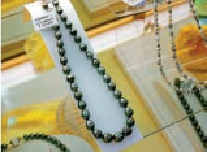Travel Reference
In-Depth Information
and their cultivation. Not many people can walk away from these black pearls without being
impressed. They are truly beautiful.
Kabira Bay Black Pearls
Just like mother-of-pearl, the smooth, lustrous inside layer of the shell of a mollusk, a pearl is formed
of calcium carbonate which, in this case, has been deposited in concentric layers around some micro-
scopic, irritaing object. Pearls can occur naturally, which is extremely rare, or can be farmed, culiv-
ated commercially, which is far more common. Whether wild or cultured, the most valuable pearls,
those considered of gemstone quality, are almost always nacreous and iridescent, that is, they appear
to glow from the surrounding light which changes with the angle upon which they are viewed. Virtu-
ally any type of a shelled mollusk can produce some kind of a pearl, but the most highly regarded are
pearl oysters from the genus Pinctada, which have been culivated especially for this purpose. Only
about half a dozen species have proven suitable. Pearl oysters are not closely related to either the
types of mussels used in freshwater pearl culivaion or to the oysters commonly eaten. Black pearls,
often called South Sea or Tahiian pearls, come from the black-lip oyster (
Pinctada margariifera
).
Mikimoto, a brand name of fine white pearls, come from the Akoya pearl oyster (
Pinctada fucata
).
The above photograph is from the Mikimoto Company's Pearl Showroom on Kabira Bay. The price for
this strand of superb black pearls is 450,000 Yen or about $5,600.
Immediately offshore from the pearl showroom you'll see a pair of fairly good-sized islets
almost blocking the entrance to Kabira Bay. These are Kojima and Majibanari. There are ac-
tually tiny third and fourth ones too, but they do not have names and don't merit much dis-
cussion.
KOJIMA
(
小島
; Ko-jima). Looking east from the shore, Ko is the larger of the two islands. It's
to the right, south. It is green, covered in dense vegetation and uninhabited. The islet is at the
northeastern end of Kabira Bay and protects the harbor by effectively blocking most of the
bay's opening to the open ocean. Kojima (lit. “Little Island”) is more or less an oval and is not
so little. It measures 3,610 feet (1,100 meters) from north to south and 1,640 feet (500 meters)

